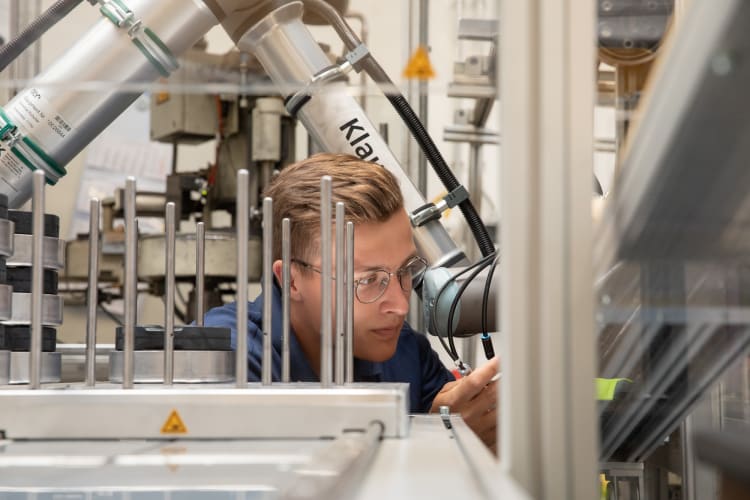
The latest data from the International Federation of Robotics (IFR) indicate that in 2024, 542,000 new industrial robots were installed worldwide, the same as in the previous year. The largest market was China with 295,000 installations, accounting for over 54% of global installations. Japan, the United States, South Korea and Germany also made the top five. Poland, with 2,344 new robots, ranked 20th globally and 8th in Europe, ahead of the Netherlands, the Czech Republic, Austria and Denmark. In 2024, more than 64,500 cobots were sold, giving them nearly a 12% share of new installations with 13% year-on-year growth. Average robot density in manufacturing was 177 robots per 10,000 employees globally; 204 in Asia, 148 in Europe, and 131 in the Americas. Europe recorded 85,000 new installations, down 8.6% year on year.
Cobots post double-digit growth
Collaborative robots remain one of the fastest-growing market segments. In 2017, just over 11,000 were installed, representing 2.8% of all new installations. By 2023 this had risen to over 57,000 cobots and more than a 10% share, and in 2024 exceeded 64,500 units, translating into nearly a 12% share and 13% y/y growth. The rise in cobot adoption is driven by their flexibility, ease of programming, and ability to work directly with employees, supporting applications both in large plants and in SMEs.
Europe under pressure from declines
In 2024, 85,000 robots were installed in Europe, 8.6% fewer than a year earlier and at a level similar to 2022. Germany remains the leader with 26,900 installations, accounting for over one-third of deployments on the continent. Next were Italy, Spain, France and Hungary. The scale of declines varied: in France sales fell by 23.8%, in Italy by 15.7%, in the United Kingdom by 35.3%, and in Germany by 4.8%.
"Europe faces the challenge of maintaining industrial competitiveness amid global shifts" says Daniel Niepsuj, Sales Lead CEE at Universal Robots. "Robotics is becoming one of the key tools for building competitive advantage. IFR data show that despite slowdowns in parts of the economy, Europe is consistently increasing the level of automation, and the growing role of Central Europe indicates that new growth impulses may emerge here. It is worth noting that the largest investments in robots are recorded in countries where the installed base is already the highest. This reflects a work culture in which automation is naturally embedded in successive stages of production processes."
Poland: a market with potential and challenges
Poland recorded a 13% decline in installations in 2024 to 2,344 units. This is the third consecutive year of lower volume after the record set in 2021, when 3,532 robots were installed. Despite this, the country remains the largest robotics market in Central and Eastern Europe. The automotive industry accounted for the largest share with 742 units and 32% of the market. A further 60% of the volume came from new installations in the chemical and plastics industry; the metal and machinery industry; the electrical and electronics industry; the wood industry; and the food industry.

In these sectors, IFR recorded, respectively: 306 units in the chemical and plastics industry, down 2% y/y; 350 units in the metal and machinery industry, down 18%; 200 units in the electrical and electronics industry, down 42%; 101 units in the wood industry, up 63%; and 129 units in the food industry, up 2%. There are also more deployments in pharmaceuticals and logistics.
"In Poland we are seeing increasing sectoral diversification" notes Grzegorz Będkowski, Channel Development Manager at Universal Robots. "Although installations in the automotive industry remain at the highest level, interest in robotics is growing in the food, wood, and pharmaceutical sectors. It is worth emphasizing that we still have relatively low robot density, which shows huge growth potential" adds Będkowski.
The structure of applications is also important. The largest increases were recorded in the automotive sector covering vehicle and engine production, where there were 137 more installations, up 140%; in the wood and furniture industry, plus 101 installations and up 63%; and in the pharmaceutical and cosmetics sector, plus 99 units and up 16%. From an application perspective, packaging and palletizing were up 210 installations and 10%, and arc welding was up 252 installations and 12%.

"There is clearly growing interest in solutions that help where labor is in short supply — palletizing and packaging are prime examples — or that require compliance with specific standards, such as in pharmaceuticals and cosmetics. This shows a rising need for automation and greater awareness of its benefits. UR is actively expanding its portfolio, developing modular, flexible solutions that can be easily integrated across industrial sectors, and offering support in process design, training and service so that customers can make the most of automation" comments Grzegorz Będkowski, Channel Distribution Manager at Universal Robots.
At the end of 2024, 26,400 robots were operating in Poland, up 7% y/y and with average annual growth of 11% in 2019–2024. In the global ranking this puts the country in 19th place. Robot density stood at 81 robots per 10,000 manufacturing employees, including 247 in the automotive sector and 62 in other industries, which remains below levels observed in most developed economies.



